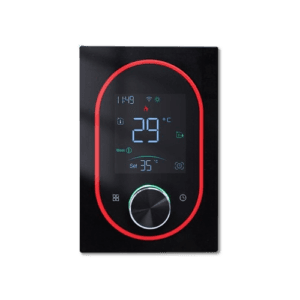방금 집 난방을 더 스마트하게 바꾸기로 결심하셨나요?
Maybe you want a thermostat you can control from your phone, or you’re tired of guessing when to turn the heater off.
그런 다음 벽판을 엽니다.
그리고 당신을 응시하는 두 개의 두꺼운 전선을 발견하세요.
"C"선도 없고, "중성선"도 없습니다.
검은색과 빨간색, 아니면 검은색과 흰색일 수도 있죠.
이것이 익숙하게 들린다면, 당신은 가정 난방 업그레이드의 가장 혼란스러운 부분 중 하나를 만난 것입니다.
선전압 배선and릴레이 전원 공급 장치.
쉽게 설명하자면,
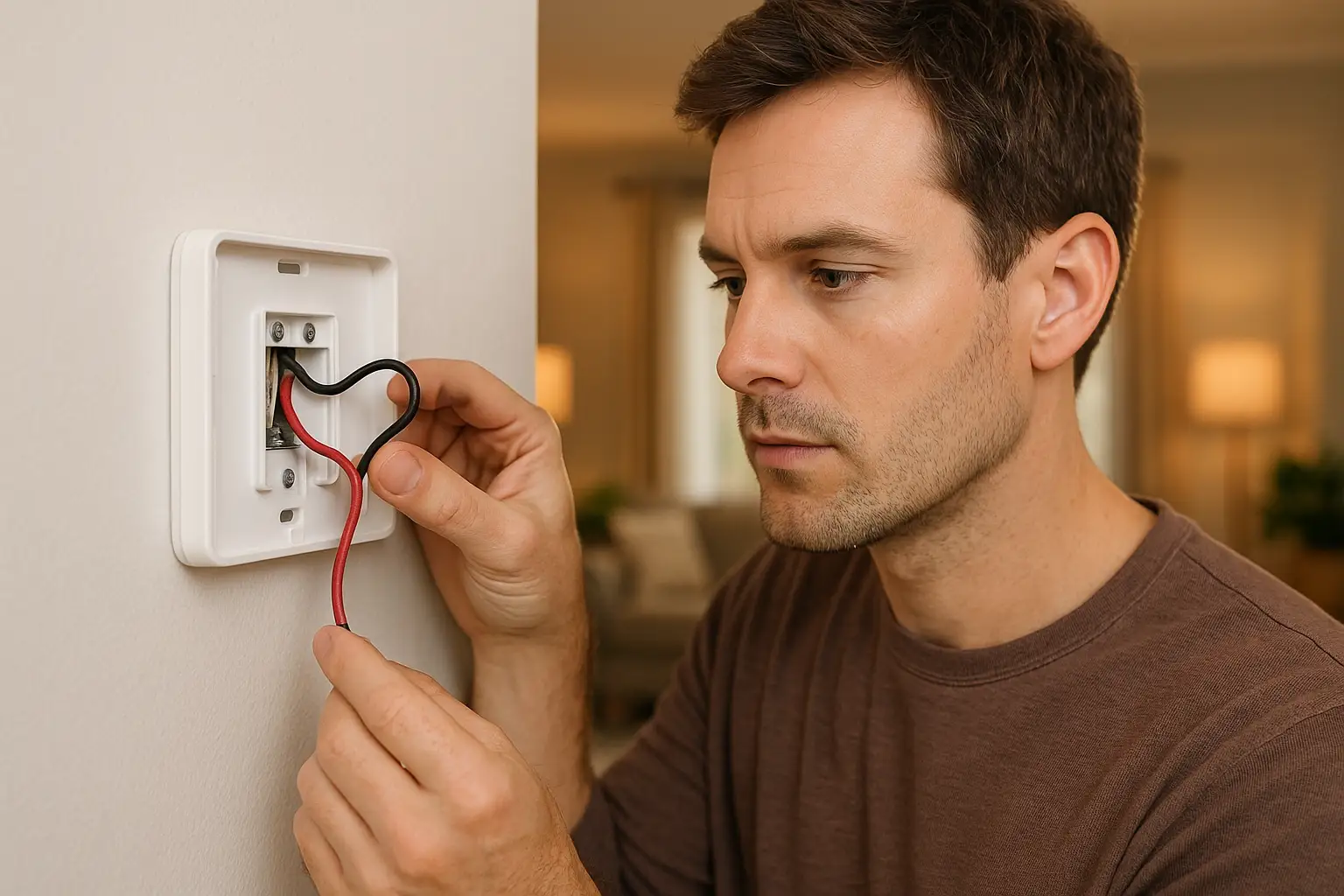
"라인 전압"의 실제 의미
북미의 대부분의 가정에서는두 가지 종류의 온도 조절 시스템, 제어하는 히터의 유형에 따라 다름:
| 유형 | 전압 | 일반적인 시스템 | 와이어 크기 | 본보기 |
|---|---|---|---|---|
| 저전압(24V) | 24볼트 | 중앙 HVAC, 히트 펌프 | 얇고 다채로운 전선 | 에코비, 네스트, 허니웰 |
| 라인 전압(120–240V) | 가정용 전원 | 전기베이스보드, 방사형 바닥 | 두꺼운 전선, 보통 검정/흰색 또는 검정/빨간색 | 기계식 또는 스마트 라인 전압 온도 조절 장치 |
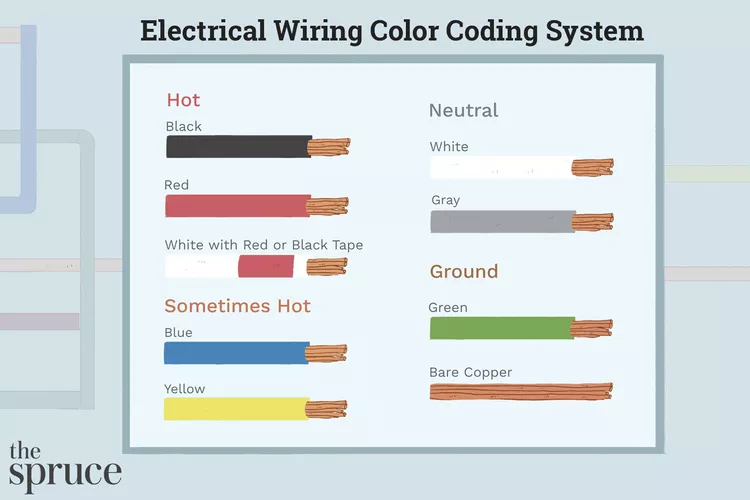
온도 조절 장치가 다음에 연결되는 경우두꺼운 전선전기베이스보드나 복사열을 제어하는 경우 거의 확실합니다.라인 전압.
즉, 전선은 콘센트에 공급되는 것과 동일한 전기를 전달한다는 의미입니다.120볼트 또는 240볼트대부분의 스마트 온도 조절 장치에 사용되는 안전한 24볼트가 아닙니다.
이것이 스마트 온도 조절 장치에 중요한 이유
문제는 다음과 같습니다.
가장 인기 있는 스마트 온도 조절기(Nest, Ecobee 등)는 다음과 같이 설계되었습니다.저전압 시스템.
If you connect them directly to line voltage, they’ll be instantly damaged — like plugging your phone into a clothes dryer outlet.
That’s why so many homeowners get stuck halfway through an installation, wondering why nothing matches.
그렇다면 히터가 120볼트나 240볼트로 작동하는 경우 어떻게 해야 할까요?
앞으로 나아갈 안전한 길은 두 가지가 있습니다.
- 릴레이 또는 접촉기 추가온도 조절 장치와 히터 사이 또는
- 라인 전압 시스템용으로 제작된 온도 조절 장치를 사용하십시오..
릴레이 전원 공급 장치의 역할
첫 번째 옵션에 대해 이야기해 보겠습니다.온도 조절 장치 릴레이 전원 공급 장치에 대한 라인 전압.
릴레이(접촉기라고도 함)는 기본적으로온도 조절 장치로 제어되는 전기 스위치.
It allows the thermostat to “tell” your high-voltage heater when to turn on, without directly carrying the dangerous current.
이렇게 생각해 보세요.
온도 조절 장치가 명령을 내리고, 릴레이가 중요한 역할을 합니다.
When the thermostat sends a small signal, the relay’s coil energizes and closes the circuit that powers your 240 V heater.
온도 조절 장치가 꺼지면 코일이 풀리고 히터 회로가 다시 열립니다.
이렇게 하면 스마트 제어 시스템이 유지됩니다.안전하고, 격리되어 있으며, 규정을 준수합니다..
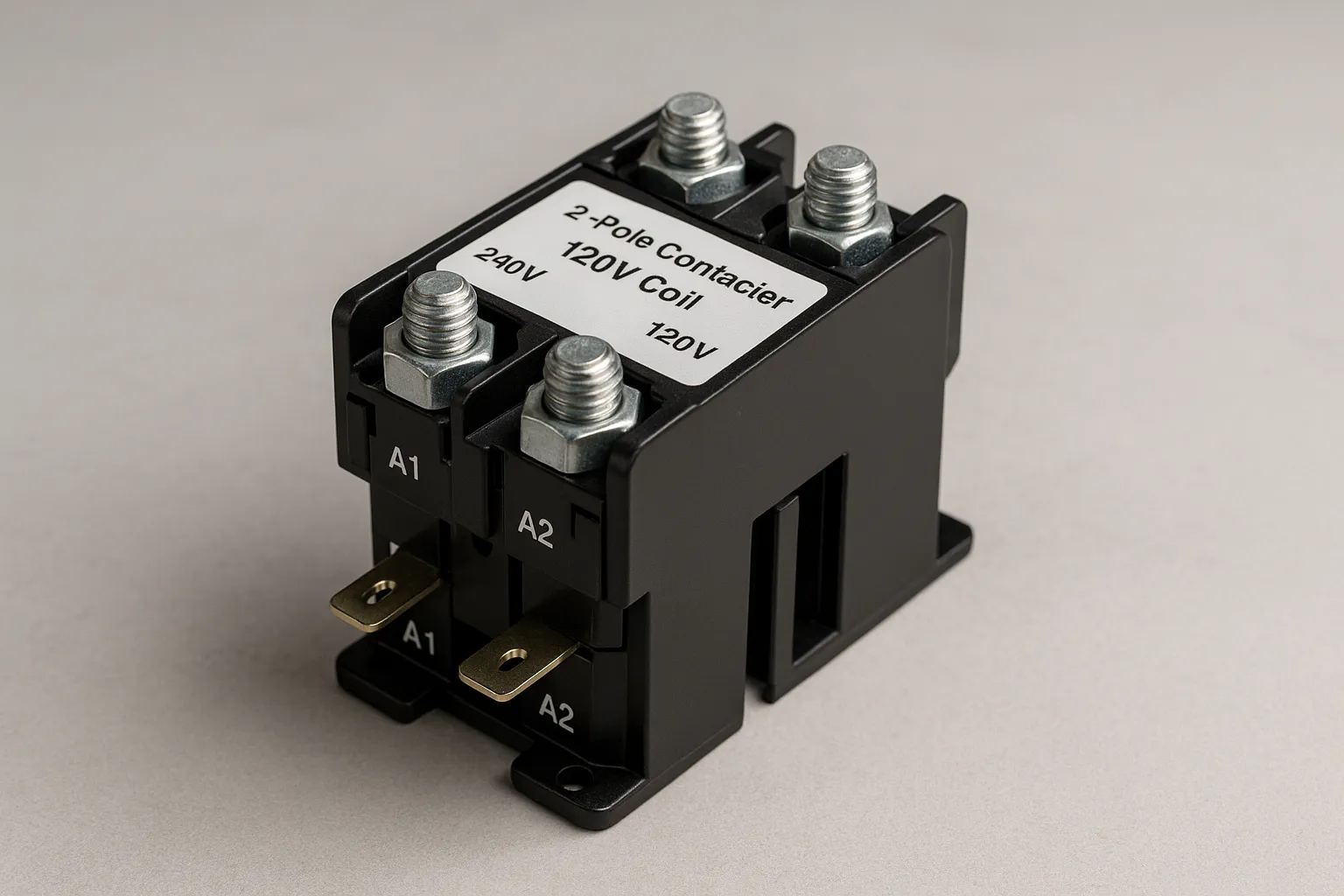
실제로 릴레이가 필요한 경우
모든 전압 공급 장치에 릴레이가 필요한 것은 아닙니다.
확인하는 방법은 다음과 같습니다.
- 회로가 제공하는 경우중성선이 있는 120V(검정색 = 뜨겁고 흰색 = 중립), 많은 전자식 전압 온도 조절 장치는 연결할 수 있습니다.곧장.
- 회로가 다음과 같은 경우2개의 뜨거운 전선이 있는 240V(검정색과 빨간색, 중립 없음), 온도 조절 장치 자체는 그 전원으로 작동할 수 없습니다.
당신은 필요합니다릴레이 또는 접촉기와 함께120V 코일둘을 연결하기 위해.
다시 말해서:
중성선이 없으면 릴레이가 필요합니다.
This setup lets the thermostat use standard 120 V power while safely switching the 240 V heater circuit through the relay.
시스템 유형을 식별하는 방법
무엇을 하기 전에, 실제로 무엇을 가지고 있는지 확인하는 것이 좋습니다.
몇 가지 간단한 단서만 있어도 몇 시간 동안의 혼란을 피할 수 있습니다.
- 브레이커 패널을 확인하세요.
- 스위치 1개 → 120V 회로일 가능성이 높음.
- 두 개의 연결된 스위치 → 240V 회로.
- 온도 조절 장치 뒤를 살펴보세요.
- 검은색 전선 1개 + 흰색 전선 1개 → 120V(중성선 있음).
- 검은색 전선 1개 + 빨간색 전선 1개 → 240V(중성선 없음).
- 전압 테스터나 멀티미터를 사용하세요(안전하게 하는 방법을 알고 있다면).
- 흑백간 120V → 직접 연결 가능.
- 검은색과 빨간색 사이 240V(중성선 없음) → 릴레이 설정 사용
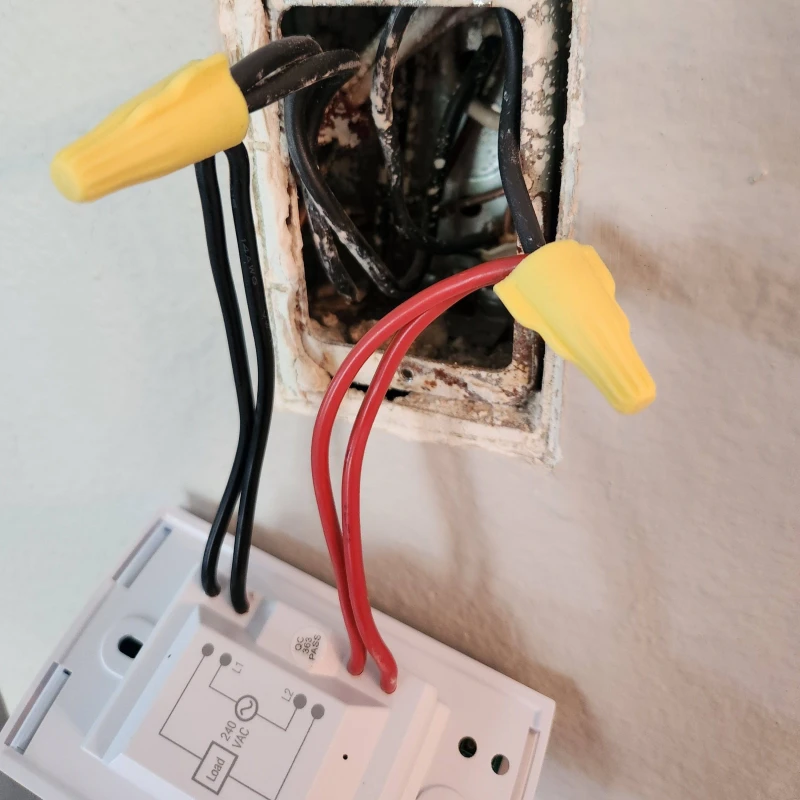
확실하지 않다면 차단기를 끄고 전기 기술자를 부르세요.
240볼트가 관련되어 있을 때는 추측할 가치가 없습니다.
일반적인 배선 예
간단한 예를 살펴보겠습니다.
240V 베이스보드 히터가 있고 120V 전원으로 작동하는 최신형 온도 조절 장치를 사용하고 싶습니다.
다음과 같은 일이 발생합니다.
- 온도 조절 장치는 120V 전선(고온 + 중성)에서 전원을 공급받습니다.
- 출력 단자는 전원을 다음 위치로 보냅니다.2극 릴레이의 코일120V에 정격됨.
- 그 릴레이는 히터로 가는 240V 전선 두 개를 전환합니다.
결과:
- 온도 조절 장치는 히터를 간접적으로 제어합니다.
- 히터는 240V의 전력을 안전하게 공급받습니다.
- 온도 조절 장치는 120V 전원으로 작동합니다.
깨끗하고 안전하며, 전문 설치자가 이런 업그레이드를 처리하는 방식입니다.
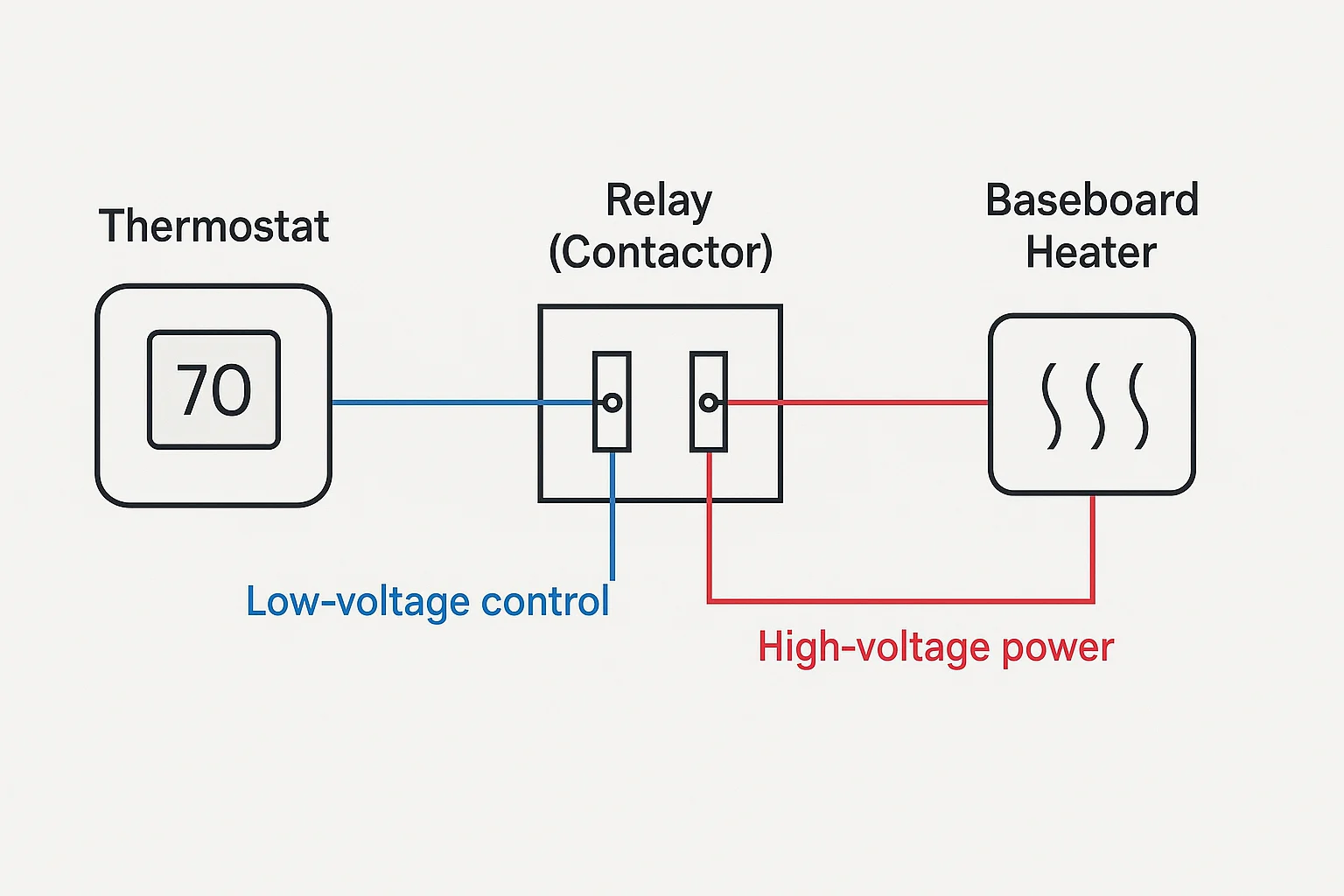
옵션 2: 라인 전압 시스템용으로 제작된 온도 조절 장치
이제 두 번째 옵션에 대해 알아보겠습니다. 가장 간단한 옵션이기도 하죠.
Some thermostats are built to handle line voltage directly, meaning they can safely control 120–240 V baseboard or radiant heaters. However, if your 240 V circuit has no neutral, a relay (contactor) may still be needed to power the thermostat’s electronics.
These thermostats connect directly to 120 V circuits and have internal relays rated for the current of typical baseboard heaters (often up to 16 amps).
They still provide digital temperature control, scheduling, and smart-home features, but without needing an extra box in your wall.
If your home already has a 120 V circuit with a neutral line, choosing one of these thermostats can save both wiring work and parts cost.
이러한 디자인의 한 예는 다음과 같습니다.__LT_무시_8_0__-BH, which supports 120 V to 240 V line-voltage heating systems. It powers itself from an L-N supply but can also control 240 V two-hot-wire circuits via a 2-pole contactor when no neutral is available.
하지만 중요한 것은 모델이 아니라호환성 원리:
온도 조절 장치를 배선 유형에 맞춰야지, 그 반대로 해서는 안 됩니다.
주요 안전 수칙
- 차단기에서 전원을 끄세요전선을 만지기 전에.
- 중성선을 두 번째 핫라인으로 사용하지 마십시오.— 안전하지 않고 코딩하지 않는 것이 좋습니다.
- 온도 조절 장치와 릴레이가 히터의 전류 소모량(암페어)에 적합한지 확인하세요.
- 따르다지역 전기 규정(미국의 경우 NEC).
- 의심스러울 때는 최종 연결 및 검사를 위해 자격을 갖춘 전기 기술자를 고용하세요.
스마트 난방은 훌륭하지만 안전이 항상 최우선입니다.
마무리하기
어떻게 이해하는지온도 조절 장치 릴레이 전원 공급 장치에 대한 라인 전압일은 전기 기술자만을 위한 것이 아닙니다.
이 제품은 오래된 난방 시스템을 안전하게 현대화하고자 하는 모든 주택 소유자를 위한 제품입니다.
간단히 요약하면 다음과 같습니다.
- 중성선으로 120V가 있는 경우→ 직접 연결되는 라인 전압 스마트 온도 조절 장치를 선택하세요.
- 240V(2개의 뜨거운 전선)가 있는 경우→ 온도 조절 장치와 릴레이(접촉기) 설정이 필요합니다.
- 확실하지 않은 경우→ 무엇이든 구매하기 전에 배선을 점검하거나 전기 기술자와 상담하세요.
시스템을 알고 나면 업그레이드가 간단하고 안전해집니다.
스마트 온도 조절 장치는 집의 효율성을 높여주지만 가장 현명한 단계는 다음과 같습니다.네 벽 뒤에는 뭐가 있어?시작하기 전에.
빠른 FAQ
라인 전압 온도 조절 장치에 릴레이가 필요합니까?
If your heater runs on 240 V and there’s no neutral wire, yes — you’ll need a 2-pole relay (or contactor) with a 120 V coil.
시스템이 중성선을 사용하여 120V인 경우 대부분의 선전압 온도 조절 장치를 직접 연결할 수 있습니다.
저전압 시스템용으로 제작된 스마트 온도 조절 장치를 사용할 수 있나요?
Not directly. Low-voltage thermostats like Nest or Ecobee are built for 24 V HVAC circuits, not 120 V or 240 V heaters.
이 장치를 전원에 연결하면 장치가 영구적으로 손상될 수 있습니다.
릴레이와 접촉기의 차이점은 무엇입니까?
이 둘은 같은 원리로 작동합니다. 즉, 작은 제어 신호가 더 큰 전원 회로를 전환합니다.
A contactor is simply a heavier-duty relay designed for high-current devices like baseboard or radiant heaters.
중성선이 중요한 이유는 무엇입니까?
Electronic line-voltage thermostats need a neutral line to power their internal display and Wi-Fi functions.
이것이 없으면 별도의 릴레이 회로와 함께 사용하지 않는 한 작동할 수 없습니다.
릴레이 배선은 어렵나요?
It’s mostly about matching terminals correctly: the thermostat controls the coil, and the relay switches the heater lines.
그래도 안전과 규정 준수를 위해 전기 기술자에게 연결 상태를 확인하는 것이 가장 좋습니다.
Ready to simplify your heating setup? Explore how a smart heating control system can connect thermostats, relays, and sensors into one efficient network — all manageable from your phone. Learn how to balance comfort and energy savings with the right setup for your home.
스마트 난방 솔루션 살펴보기 →